1995 CHEVROLET CORVETTE fuses
[x] Cancel search: fusesPage 56 of 386
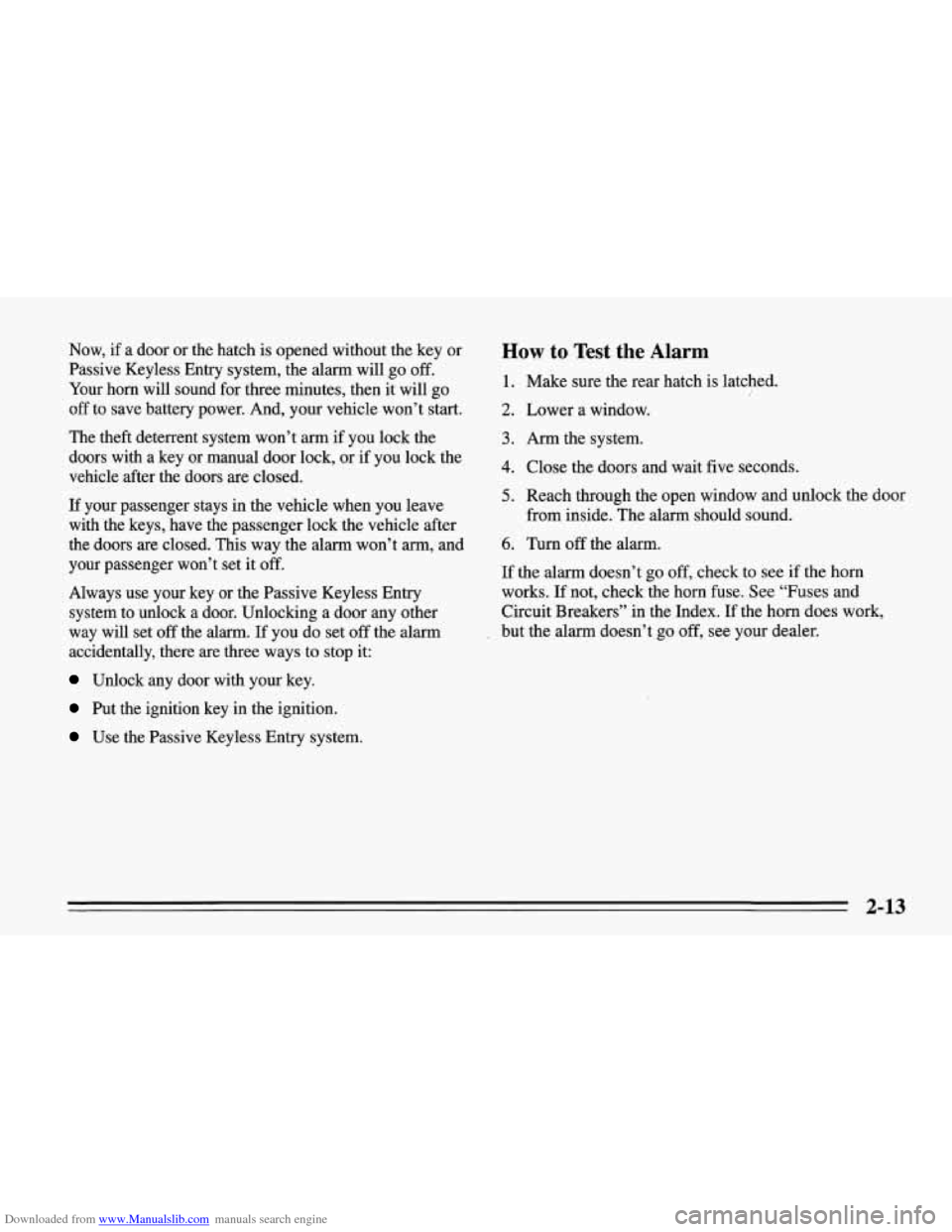
Downloaded from www.Manualslib.com manuals search engine Now, if a door or the hatch is opened without the key or
Passive Keyless Entry system, the alarm will go off.
Your horn will sound for three minutes, then it will go
off to save battery power. And, your vehicle won’t start.
The theft deterrent system won’t arm if you lock the
doors with a key or manual door lock, or if you lock the
vehicle after the doors are closed.
If your passenger stays in the vehicle when you leave
with the keys, have the passenger lock the vehicle after
the doors are closed. This way the alarm won’t
arm, and
your passenger won’t set it
off.
Always use your key or the Passive Keyless Entry
system to unlock a door. Unlocking a door any other
way will set off the alarm. If you do set off the alarm
accidentally, there are three ways to stop it:
Unlock any door with your key.
Put the ignition key in the ignition.
Use the Passive Keyless Entry system.
How to Test the Alarm
1. Make sure the rear hatch is latched.
2. Lower a window.
3. Arm the system.
4. Close the doors and wait five seconds.
5. Reach through the open window and unlock the door
from inside. The alarm should sound.
6. Turn off the alarm.
If the alarm doesn’t go off, check to see if the horn
works. If not, check the horn fuse. See “Fuses and
Circuit Breakers” in the Index. If the
horn does work,
. but the alarm doesn’t go off, see your dealer.
2-13
Page 57 of 386
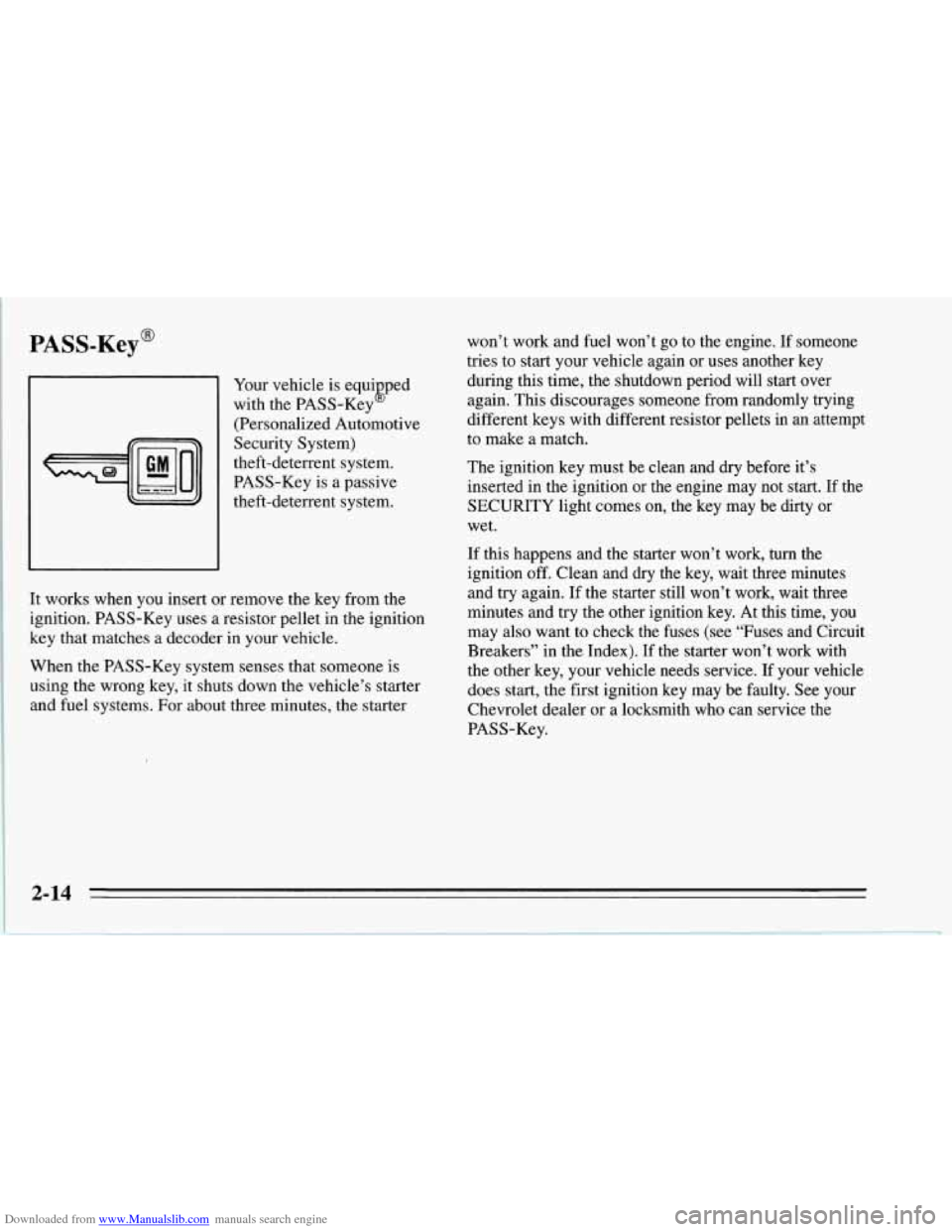
Downloaded from www.Manualslib.com manuals search engine PASS-Key@
Your vehicle is equi ped
with the PASS-Key
(Personalized Automotive
Security System)
theft-deterrent system.
PASS-Key is a passive
theft-deterrent system.
It works when you insert or remove the key from the
ignition. PASS-Key uses a resistor pellet in the ignition
key that matches a decoder in your vehicle.
When the PASS-Key system senses that someone is
using the wrong key, it shuts down the vehicle’s starter
and fuel systems. For about three minutes, the starter won’t work and
fuel won’t go to the engine. If someone
tries to start your vehicle again or uses another key
during this time, the shutdown period will start over
again. This discourages someone from randomly trying
different keys with different resistor pellets in an attempt
to make a match.
The ignition key must be clean and dry before it’s
inserted in the ignition or the engine may not start. If the
SECURITY light comes on, the key may be dirty or
wet.
If this happens and the starter won’t work, turn the
ignition
off. Clean and dry the key, wait three minutes
and
try again. If the starter still won’t work, wait three
minutes and try the other ignition key. At this time, you
may also want to check the fuses (see “Fuses and Circuit
Breakers” in the Index). If the starter won’t work with
the other key, your vehicle needs service.
If your vehicle
does start, the first ignition key may be faulty. See your
Chevrolet dealer or a locksmith who can service the
PASS-Key.
2-14
Page 83 of 386
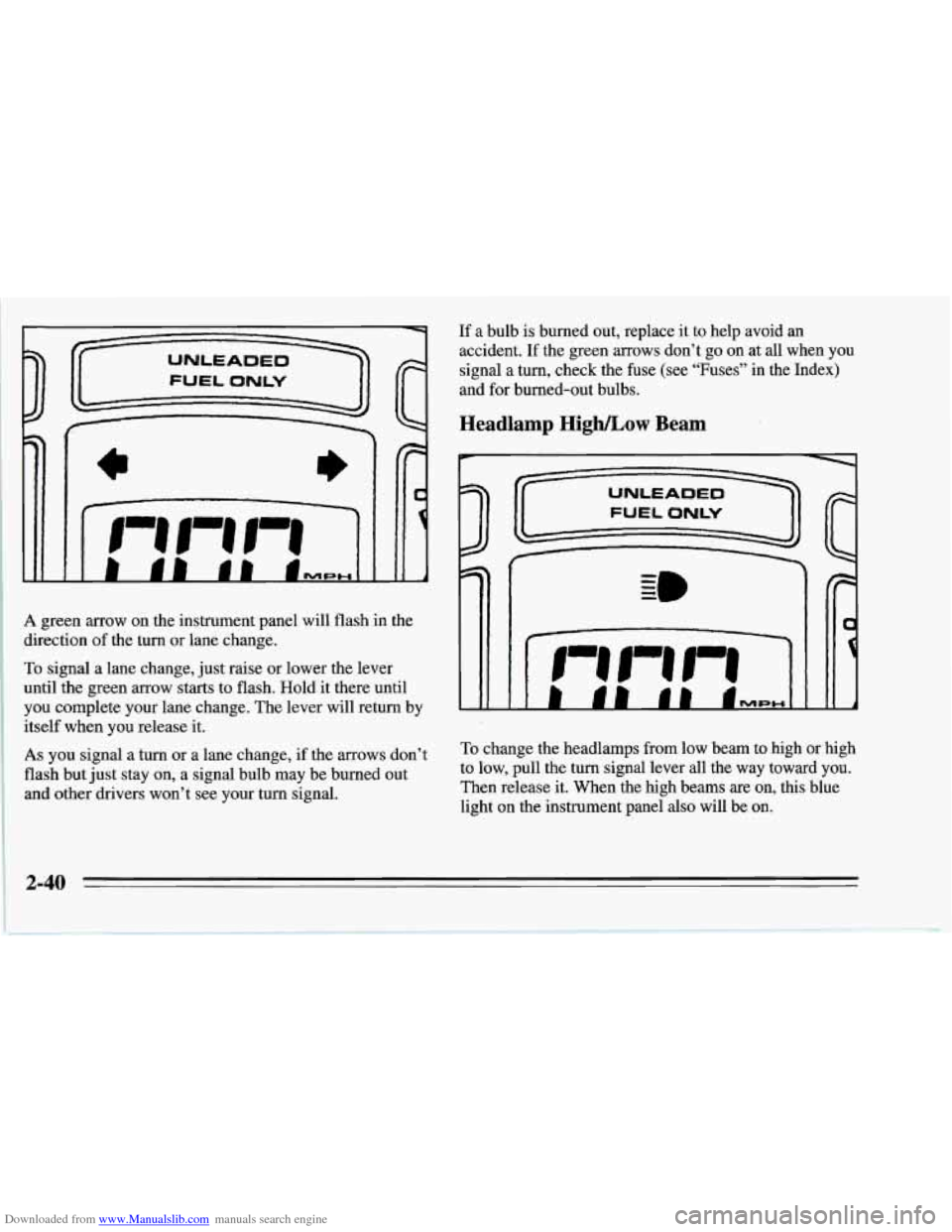
Downloaded from www.Manualslib.com manuals search engine A green arrow on the instrument panel will flash in the
direction
of the turn or lane change.
To signal a lane change, just raise or lower the lever
until the green arrow starts to flash. Hold it there until
you complete your lane change. The lever will return by
itself when you release it.
As you signal a turn or a lane change, if the arrows don’t
flash but just stay on, a signal bulb may be’burned out
and other drivers won’t see your turn signal.
If a bulb is burned out, replace it to help avoid an
accident. If the green arrows don’t go on at all when you
signal a turn, check the fuse (see “Fuses” in the Index)
and for burned-out bulbs.
Headlamp HighLow Beam
P
1 1
To change the headlamps from low beam to high or high
to low, pull the turn signal lever all the way toward you.
Then release it. When the high beams are
on, this blue
light
on the instrument panel also will be on.
2-40
Page 151 of 386
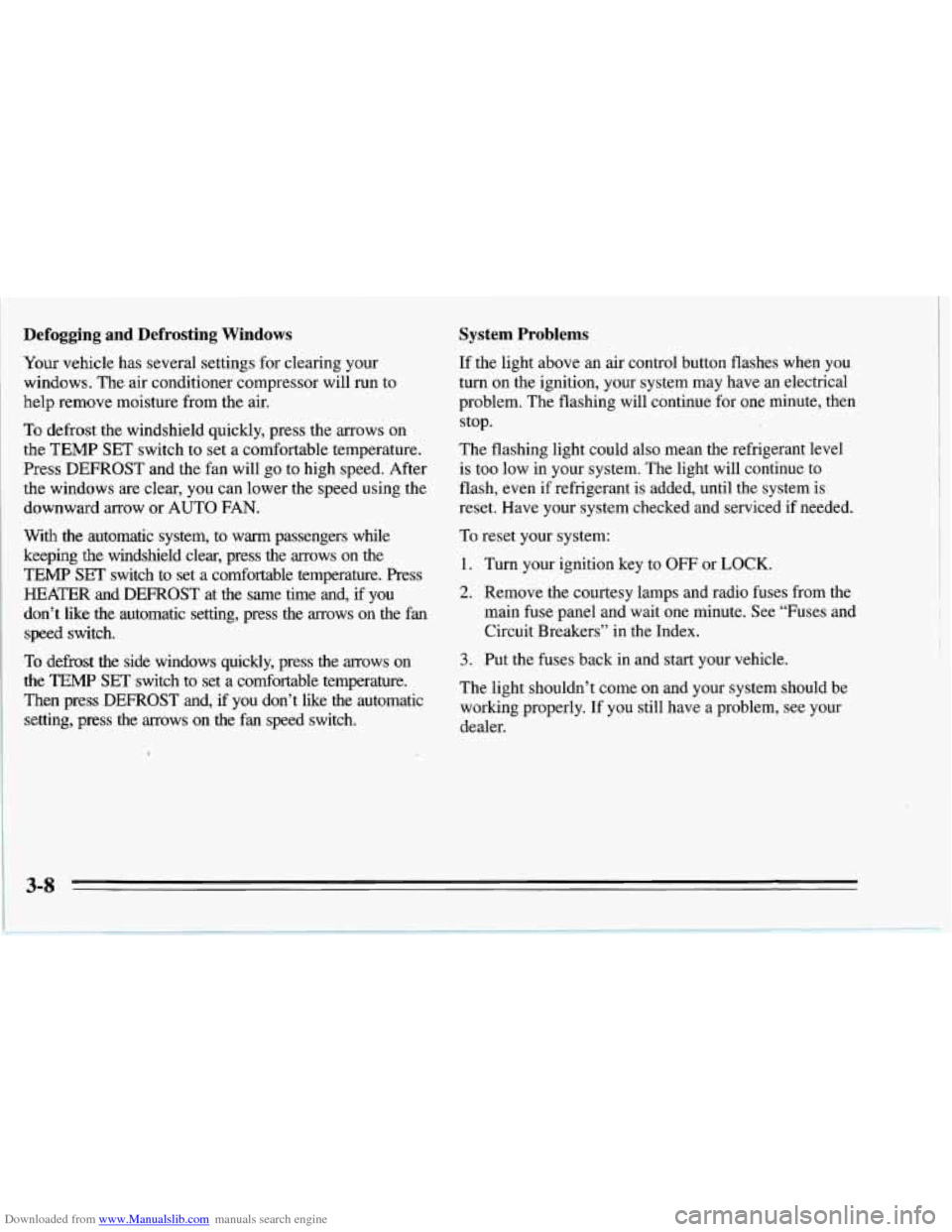
Downloaded from www.Manualslib.com manuals search engine Defogging and Defrosting Windows
Your vehicle has several settings for clearing your
windows. The air conditioner compressor will run to
help remove moisture from the air.
To defrost the windshield quickly, press the arrows on
the
TEMP SET switch to set a comfortable temperature.
Press DEFROST and the fan will go to high speed. After
the windows are clear, you can lower the speed using the
downward arrow or
AUTO FAN.
With the automatic system, to warm passengers while
keeping the windshield clear? press the arrows on the
TEMP SET switch to set a comfortable temperature. Press
HEATER and DEFROST at the same time and, if you
don’t like the automatic setting, press the
arrows on the fan
speed switch.
To defrost the side windows quickly, press the arrows on
the
TEMP SET switch to set a comfortable temperature.
Then press DEFROST and,
if you don’t like the automatic
setting, press the arrows on the fan speed switch.
System Problems
If the light above an air control button flashes when you
turn on the ignition, your system may have an electrical
problem. The flashing will continue for one minute, then
stop.
The flashing light could also mean the refrigerant level
is too low in your system. The light will continue to
flash, even if refrigerant is added, until the system is
reset. Have your system checked and serviced if needed.
To reset your system:
1. Turn your ignition key to OFF or LOCK.
2. Remove the courtesy lamps and radio fuses from the
main fuse panel and wait one minute. See “Fuses and
Circuit Breakers” in the Index.
3. Put the fuses back in and start your vehicle.
The light shouldn’t come on and your system should be
working properly. If you still have a problem, see your
dealer.
Page 302 of 386
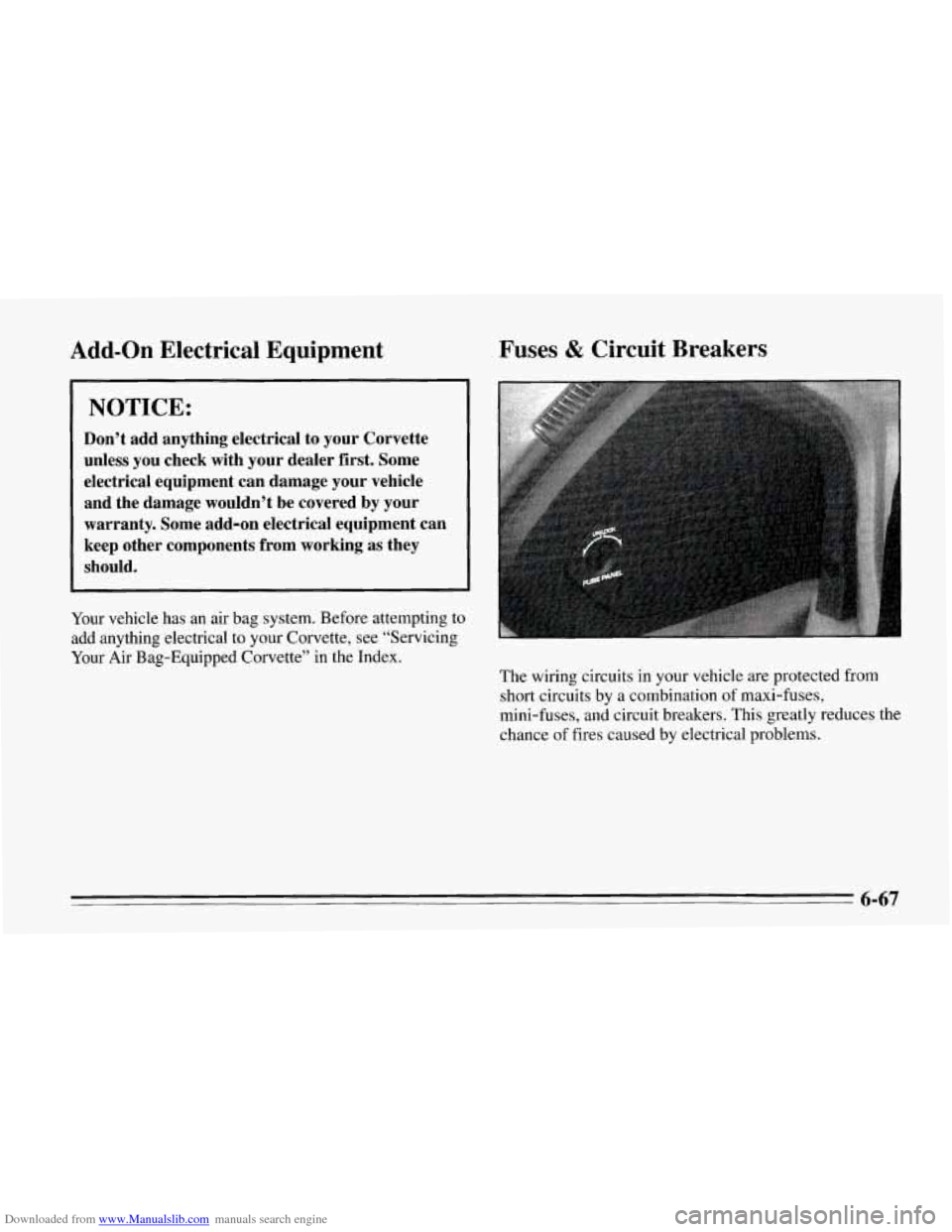
Downloaded from www.Manualslib.com manuals search engine Add-on Electrical Equipment Fuses & Circuit Breakers
NOTICE:
Don’t add anything electrical to your Corvette
unless you check with your dealer first. Some
electrical equipment can damage your vehicle
and the damage wouldn’t be covered by your warranty. Some add-on electrical equipment can
keep other components from working as they
should.
Your vehicle has an air bag system. Before attempting to
add anything electrical to your Corvette, see “Servicing
Your Air Bag-Equipped Corvette” in the Index.
The wiring circuits in your vehicle are protected from
short circuits by a combination
of maxi-fuses,
mini-fuses, and circuit breakers. This greatly reduces the
chance
of fires caused by electrical problems.
6-67
Page 303 of 386
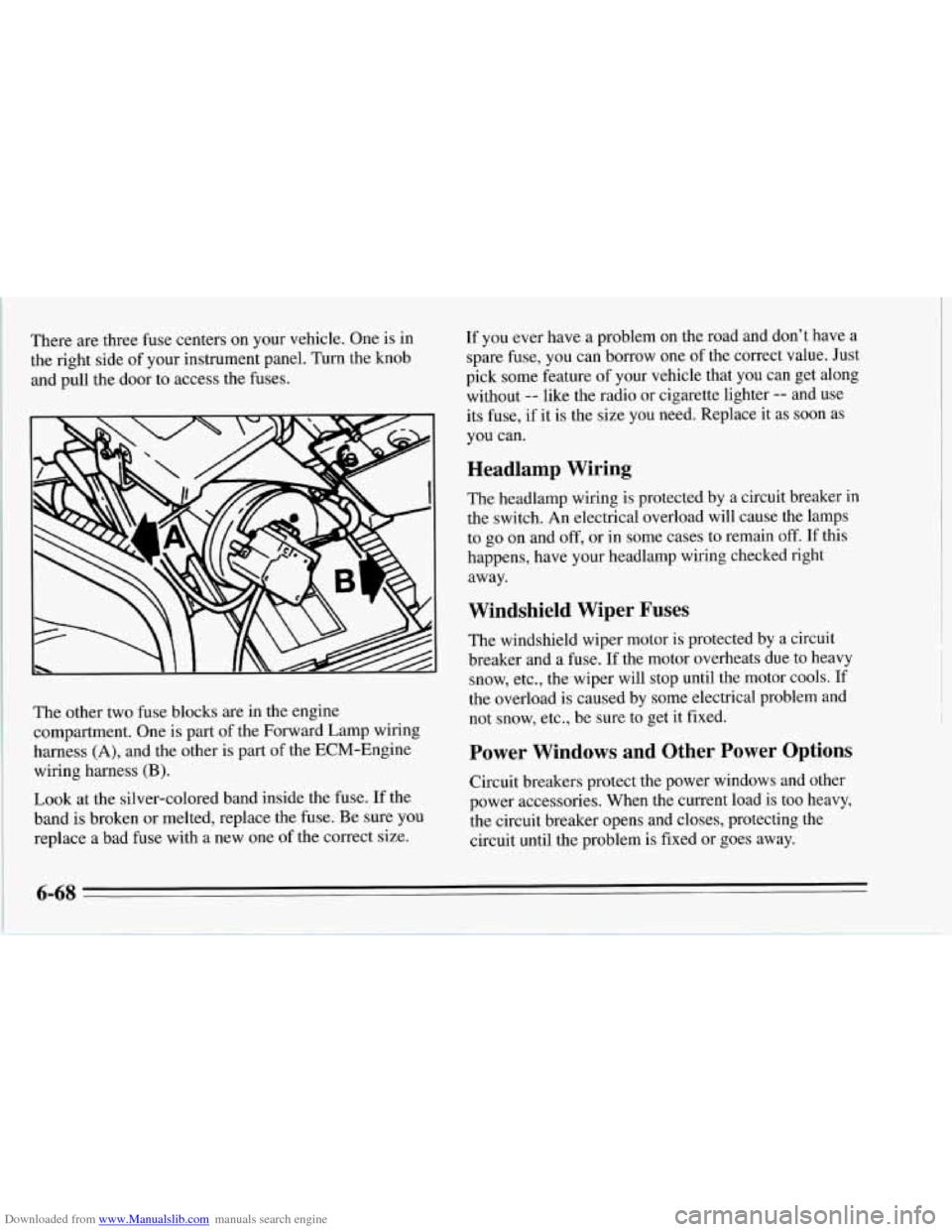
Downloaded from www.Manualslib.com manuals search engine There are three fuse centers on your vehicle. One is in
the right side of your instrument panel. Turn the knob
and pull the door to access the fuses.
The other two fuse blocks are in the engine
compartment. One
is part of the Forward Lamp wiring
harness
(A), and the other is part of the ECM-Engine
wiring harness
(B).
Look at the silver-colored band inside the fuse. If the
band
is broken or melted, replace the fuse. Be sure you
replace a bad fuse with a new one
of the correct size.
If you ever have a problem on the road and don’t have a
spare fuse, you can borrow one of the correct value. Just
pick some feature
of your vehicle that you can get along
without
-- like the radio or cigarette lighter -- and use
its fuse, if it is the size you need. Replace it as soon as
you can.
Headlamp Wiring
The headlamp wiring is protected by a circuit breaker in
the switch. An electrical overload will cause the lamps
to
go on and off, or in some cases to remain off. If this
happens, have your headlamp wiring checked right
away.
Windshield Wiper Fuses
The windshield wiper motor is protected by a circuit
breaker and a
fuse. If the motor overheats due to heavy
snow, etc., the wiper will stop until the motor cools. If
the overload is caused by some electrical problem and
not snow, etc., be sure to get it fixed.
Power Windows and Other Power Options
Circuit breakers protect the power windows and other
power accessories. When the current load is too heavy,
the circuit breaker opens and closes, protecting the
circuit until the problem is fixed or goes away.
6-68
Page 378 of 386
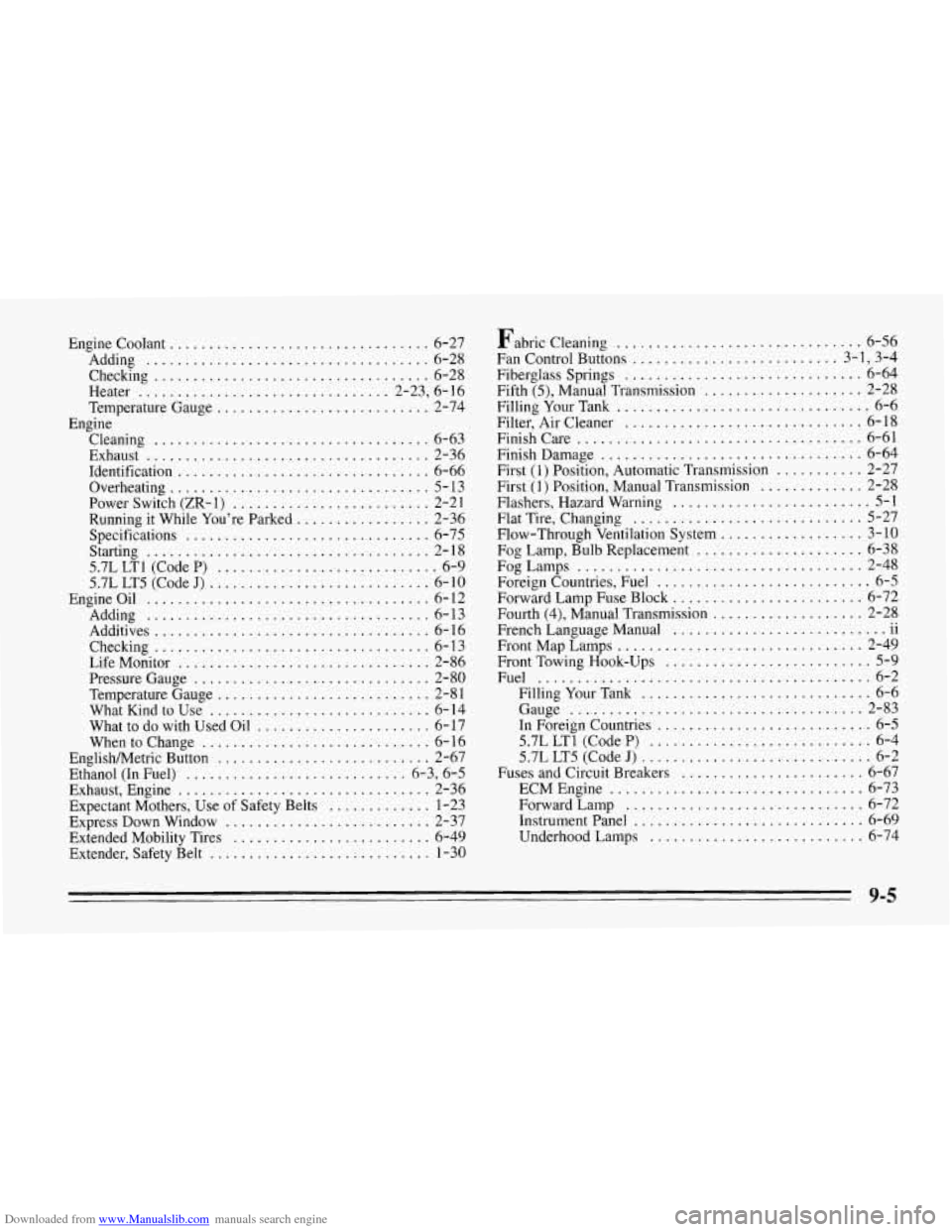
Downloaded from www.Manualslib.com manuals search engine Engine Coolant ................................. 6-27
Adding
.................................... 6-28
Checking
................................... 6-28
Heater
................................ 2-23, 6-16
Temperature Gauge
........................... 2-74
Engine
Cleaning
................................... 6-63
Exhaust
.................................... 2-36
Identification
................................ 6-66
Overheating
................................. 5-13
Power Switch (ZR-
1) ......................... 2-2 1
Running it While You’re Parked ................. 2-36
Specifications
............................... 6-75
5.7L LT1 (Code P) ............................ 6-9
5.7L LT5 (Code
J) ............................ 6- 10
Adding .................................... 6-13
Additives
................................... 6-16
Checking
................................... 6-13
Life Monitor
................................ 2-86
Pressure Gauge
.............................. 2-80
Temperature Gauge
........................... 2-8 1
What Kind to Use
............................ 6-14
What to do with Used Oil
...................... 6-17
When to Change
............................. 6- 16
EnglishMetric Button
........................... 2-67
Ethanol (In Fuel)
............................ 6-3, 6-5
Exhaust, Engine ................................ 2-36
Expectant Mothers, Use of Safety Belts
............. 1-23
Express Down Window
.......................... 2-37
Extended Mobility Tires
......................... 6-49
Extender, Safety Belt
............................ 1-30
Starting
.................................... 2-18
Engineoil
.................................... 6-12 Fabric
Cleaning
............................... 6-56
Fan Control Buttons
.......................... 3.1, 3.4
Fiberglass Springs
.............................. 6-64
Fifth (5). Manual Transmission
.................... 2-28
Filling Your Tank
................................ 6-6
Filter. Air Cleaner
.............................. 6-18
Finish Care
.................................... 6-61
Finish Damage
................................. 6-64
First
(1) Position. Manual Transmission ............. 2-28
Flashers. Hazard Warning
......................... 5-1
Flat Tire. Changing ............................. 5-27
Flow-Through Ventilation System
.................. 3-10
Fog Lamp. Bulb Replacement ..................... 6-38
Fog Lamps
.................................... 2-48
Foreign Countries. Fuel
........................... 6-5
Forward Lamp Fuse Block
........................ 6-72
Fourth (4). Manual Transmission
................... 2-28
French LanguageManual
........................... 11 ..
Front Map Lamps ............................... 2-49
Front Towing Hook-Ups
.......................... 5-9
Fuel
.......................................... 6-2
FillingYourTank
............................. 6-6
Gauge
..................................... 2-83
First (1) Position. Automatic Transmission
........... 2-27
In Foreign Countries
........................... 6-5
5.7L LTl (Code P)
............................ 6-4
5.7L LT5 (Code
J) ............................. 6-2
Fuses and Circuit Breakers
....................... 6-67
Forward Lamp
.............................. 6-72
Instrument Panel
............................. 6-69
Underhood Lamps
........................... 6-74
ECMEngine
................................ 6-73
9-5
Page 385 of 386
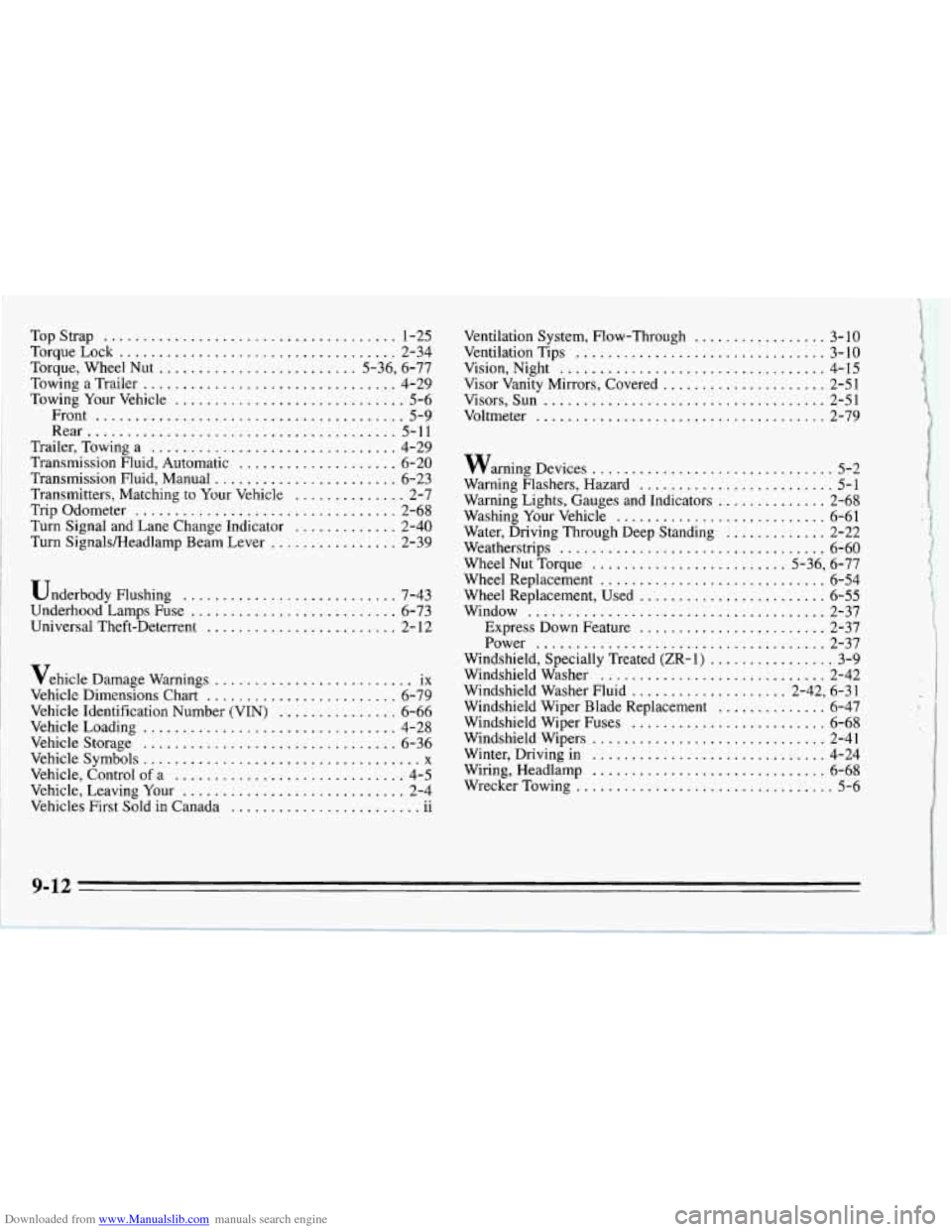
Downloaded from www.Manualslib.com manuals search engine TopStrap ..................................... 1-25
TorqueLock
................................... 2-34
Torque. Wheel Nut
......................... 5.36. 6.77
Towing a Trailer
................................ 4-29
Towing Your Vehicle
............................. 5-6
Trailer, Towing a
............................... 4-29
Transmission Fluid, Automatic
.................... 6-20
Transmission Fluid, Manual
....................... 6-23
Transmitters, Matching to Your Vehicle
.............. 2-7
Trip Odometer
................................. 2-68
Turn Signal and Lane Change Indicator
............. 2-40
Turn Signals/Headlamp Beam Lever
................ 2-39
Front
....................................... 5-9
Rear
....................................... 5-11
Underbody Flushing
........................... 7-43
Underhood Lamps Fuse
.......................... 6-73
Universal Theft-Deterrent
...................... 2- 12
Vehicle Damage Warnings
......................... ix
Vehicle Dimensions Chart
........................ 6-79
Vehicle Identification Number (VIN)
............... 6-66
Vehicle Loading
................................ 4-28
Vehicle Storage
................................ 6-36
Vehicle Symbols ................................... x
Vehicle. Leaving Your
............................ 2-4
Vehicle.
Control of a
............................. 4-5
Vehicles First
Sold in Canada 11 .. ........................
Ventilation System. Flow-Through ................. 3- 10
Ventilation Tips
................................ 3-10
Visor Vanity Mirrors, Covered
..................... 2-51
Visors, Sun
.................................... 2-51
Vision.
Night
.................................. 4-15
Voltmeter
..................................... 2-79
warning Devices
............................... 5-2
Warning Flashers. Hazard
......................... 5-1
Washing Your Vehicle ........................... 6-61
Weatherstrips
.................................. 6-60
Wheel Nut Torque
......................... 5-36. 6-77
Wheel Replacement
............................. 6-54
Wheel Replacement. Used
........................ 6-55
Window
...................................... 2-37
Express Down Feature
........................ 2-37
Power
..................................... 2-37
Windshield, Specially Treated (ZR-
1) ................ 3-9
Windshield Washer ............................. 2-42
Windshield Washer Fluid
.................... 2-42. 6-31
Windshield Wiper Blade Replacement
.............. 6-47
Windshield Wiper Fuses
......................... 6-68
Windshield Wipers
.............................. 2-41
Winter, Driving in
.............................. 4-24
Wiring, Headlamp
.............................. 6-68
Wrecker Towing
................................. 5-6
Warning
Lights. Gauges and Indicators
.............. 2-68
Water. Driving Through Deep Standing
............. 2-22
9-12